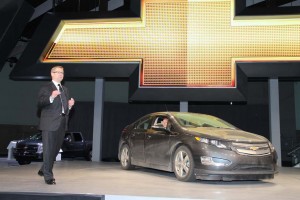In a move of the significance seldom seen in the advertising world, General Motors has named Carat, part of the giant Aegis group, its global media and planning agency – a deal worth $3 billion annually, and perhaps significantly more in the coming years. The move comes after a shoot-out among four major agencies, including Publicis Group’s Starcom, which had been handling media duties in North America, where two-thirds of GM’s advertising budget was traditionally tallied.
(Click Here for the breaking news.)
The global realignment is just the latest in a series of steps that have been taken since former Hyundai Motor America marketing chief Joel Ewanick relocated to Detroit nearly two years ago. But the 51-year-old Ewanick, in an exclusive interview with TheDetroitBureau.com, says it’s not about to be the last big change. Among other things, he confirms the results of a review of Chevrolet’s creative account will be announced in the coming weeks, with other big moves to follow.
Ewanick also stressed that the marketing and media changes are just part of a broader shake-up within General Motors designed to create a leaner, more nimble manufacturer that has clearly defined its brands and is now rolling out the appropriate products to keep its momentum going. Considering GM last year regained its perch as the world’s largest automaker, that’s no easy challenge.
Here’s what Ewanick had to say about the latest developments and what they mean for GM longer-term:
DetroitBureau: I see we’ve caught you on your cellphone. Perhaps you’re hiding out considering today’s decision must have gotten some powerful people mighty angry?
Ewanick: “I’m not hiding but it was really a lot of tough day. There are a lot of good people but we had to step back and decide what was the right decision for GM on a global basis. It drives a real cultural change that we needed desperately. And it signifies this is a very different way of doing business at GM that forced a lot of cross-disciplinary teams to come together: marketing, legal, purchasing, sales, teams from all the different regions. That said, it’s tough for Starcom after a decade of doing business for GM.
DetroitBureau: Traditionally, GM operated in chimneys. Different departments didn’t talk much to each other, and even within marketing and advertising, folks in, say, the U.S. and Europe likely wouldn’t coordinate their decisions.
Ewanick: “What you’re seeing now is the real reason why GM Chairman Dan Akerson appointed a global marketing chief in the first place. And this is just the first of many decisions to come. We’re already seeing the benefits of taking advantage of our scale. We’re one of the world’s largest automakers but we hadn’t been taking advantage of our scale. This is a revolution inside General Motors. I just gave a talk to the top 300 executives at General Motors and they applauded this, recognizing we could have done this five, six year ago. But we’re catching up fast.
Detroit Bureau: How will this affect the way GM operates beyond just the act of advertising and marketing?
Ewanick: You can already see in (global product development chief) Mary Barra’s organization how she is doing the same thing, using her scale to look around the world to leverage scale and build better cars. It’s just that the act of developing cars won’t come together quite as fast. Our changes, you’ll see the impact in a matter of weeks. You’re seeing this (strategy) everywhere, in marketing, in product development, in purchasing. We came out of a dark hour and realized we had to change.
DetroitBureau: How does this impact the review of your Chevrolet advertising?
Ewanick: There’s a global review of Chevrolet and we’re a few weeks away from making a final decision (because) a few critical issues have to be addressed. The media transition will begin as fast as we can do it…all over the world. The biggest impact will be in North America. There’ll be very little transition in Europe because Carat already handles Opel, Vauxhall and Chevrolet there. Carat has promised there will be no disruptions.
DetroitBureau: Does this suggest that Carat has a lead in getting Chevrolet after the review is completed?
Ewanick: It may be a little premature on that one. We’re looking for synergies to make creative and media teams work together more closely. In the past they operated like two different silos. Going forward, it’s going to feel more like one team, a (single) marketing organization with a much deeper integration. Whoever we bring in on the creative side there will be integration on the creative side. So it’s not dependent (on shifting to Carat for creative, too).
DetroitBureau: So, after that review, what are the next big moves coming from your marketing operation?
Ewanick: Once we get through with Chevrolet, we’ll start looking at things on a more global basis that will help us market Chevrolet and Cadillac, whether that be music or sports or philanthropy, we’ll start to do those things globally, rather than by country or region. In February and March you’ll start seeing examples of this. And hope that by summer we’ll have tangible examples all over the world.
DetroitBureau: Is GM’s global marketing unit increasing its role in vehicle design and development, too?
Ewanick: One of the most encouraging things I have seen since I came to General Motors is the personal relationship I have built with (global design chief) Ed Welburn. I ask for his advice on marketing decisions and vice versa. That kind of collaboration, you’ll see more and more of that over the years. There’s a much strong collaboration with product development, too. I’m joined at the hip with the head of product planning.
DetroitBureau: This is a fundamental rethinking of how GM operates.
Ewanick: I have to give credit to Dan Akerson. These are the things he has been pushing throughout the organization, big and small. It’s a challenge. This is a big company and it won’t happen overnight. But it is happening. Look at Chevrolet; they sold 4.75 million cars around the world last year, a record. But our goal is do even better this year.
DetroitBureau: We’ve seen other makers try to globalize advertising and marketing. There was Ford 2000, a grand plan that the maker quickly had to retrench from, finding it very difficult to market to the world from Dearborn. What’s different now – for you?
Ewanick: From a good standpoint, all good marketing starts locally. We want to create tools and mechanisms that make it more efficient whatever we do on a local basis. We don’t want to lose those local insights that make it possible to market in various regions. But where we can centralize some of that, we will. There’s a way to incorporate those local insights that resonate with consumers around the world. And we’ve spent the last year trying to isolate the essence of what Chevrolet is that we want to project everywhere around the world. We even have consensus in China and India and Brazil in the marketing bible.
DetroitBureau: Speaking of: China, India and Brazil won’t be rolled into the new global media strategy. Isn’t that a challenge considering their growing importance?
Ewanick: You’ll see we have mechanisms to make Brazil less of an issue. And with our Chinese partners we will be able to work out the tonality and messaging for the brands and they may choose to fold in at a later date, even next year.


